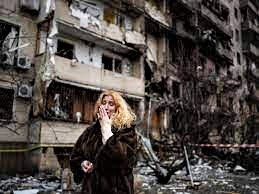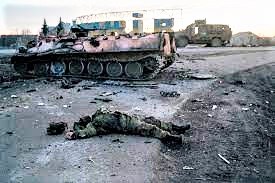 BY RICHARD TAYLOR
BY RICHARD TAYLOR
Our aim is to understand Ukraine’s counteroffensive against Russian forces and how it might affect prospects for peace. To do so we need to know about goals, troop strength, weapons, strategy and tactics. What we can’t possibly grasp but must somehow sense is the tens of thousands of soldiers on both sides shot to pieces, burned, crushed, traumatized and horribly wounded, along with shattered towns and villages, grieving families, lost hopes and dreams—a sorrow so deep and wide that we shudder to comprehend it. So, not only do we seek to understand, but, somehow, speed the end of the killing.
The context
Russia first invaded Ukraine in 2014 by occupying and annexing Crimea. In February 2022, the Russian Armed Forces (RAF) seized 23% of Ukraine. That was reduced to 17% when Ukraine counterattacked later that year. After that, other than Russia’s grinding seizure of Bakhmut, the front line stabilized until the Armed Forces of Ukraine (AFU) began its counteroffensive on June 4, 2023. It seeks to split Russian forces, drive to the Sea of Azov, and cut the land bridge between Russia and Crimea, squeezing off the RAF’s supply line and crippling its operations.
That’s a formidable task for the AFU. Unlike its offensive in 2022, it confronts greatly strengthened Russian forces. The many months of lull in the fighting has allowed the RAF to build three lines of defense that include drones, tank traps, trench lines, vast minefields, a 5-to-1 or more advantage in artillery, satellite coordination, and command of airspace, a vital aspect missing earlier in the war. As retired Brig. Gen. Mark Kimmitt puts it, the AFU faces “an obstacle belt from hell.” These strengths are magnified by the open terrain that the AFU must cross, leaving it vulnerable to withering fire.
And while the AFU has an array of NATO-supplied modern weapons, its eight brigades of about 160,000 troops trained by NATO are taking on 300,000 Russian troops with 450,000 more in reserve in Russia.
 The guns of June
The guns of June
As the fighting loomed, Army Gen. Mark Milley, the chairman of the Joint Chiefs of Staff, spoke gravely: “This is a very difficult fight. It’s a very violent fight, and it will likely take a considerable amount of time and at high cost.” Military historian Vlad Mykhnenko added that the counteroffensive is “the first major international military operation of this scale that has been done without much air support.”
On June 8, four days after the counteroffensive began, events confirmed their words when the AFU suffered a stinging rebuff. Setting off from Mala Tokmachka in southern Ukraine’s Zaporizhzhia oblast (similar to a state or province), the AFU tried to capture the town of Robotyne, a Russian strongpoint. Before it reached the first defensive line, the AFU encountered dense minefields, smothering artillery fire, and rocket fire from helicopter gunships. In the process, it lost 15% of the two brigades committed to the action. Lost too were dozens of NATO’s best vehicles including seven of the 17 German Leopard tanks that were supposed to be game changers. One senior U.S. official described the outcome as “sobering.”
From blitzkrieg to slugfest
More than sobering, the June 8 battle changed the nature of the war, moving it to a war of attrition from one of swift territorial seizure. Both sides have made local gains but little else. Should this persist, victory usually goes to the armed forces that can fight on the longest. Given the RAF’s current force advantage, experts such as John Mearsheimer and Scott Ritter are predicting a Russian victory.
However, that’s not obvious. First, we can’t exclude the possibility that all sides lose if the war leads to World War III. World Wars I and II started as clashes between two countries in Eastern Europe.
Second, although the economy of the Russian Federation (RF) has performed better than expected, thousands of hi-tech workers have emigrated. Over time, given the furious pace of hi-tech innovation, Russia’s restricted access to it will further hamper its struggle to keep up.
Next, as long as the war goes on, Moscow will be forced to divert vital resources to weapons production. And there’s another depleting vital resource: the 48,000 RAF soldiers who have perished and the many more thousands wounded—this in a country whose population is going down.
Finally, despite the RAF’s advantages, NATO rededicated itself at the Vilnius summit to equip the AFU with ever more lethal weapons. The French are providing long range SCALP missiles, the Dutch are training Ukrainian pilots to fly F-16s, and Biden approved cluster bombs—all steps up the escalation ladder.
On the other hand, the war has disrupted trade between Western Europe and Russia, especially in the energy sector. German’s economy is not only slumping, but its leaders also fret about “deindustrialization.” As Hans-Jürgen Völz, chief economist of the BVMW, a lobby for Germany’s medium-sized firms puts it, “One sometimes hears about ‘creeping deindustrialization’—well, it’s not just creeping anymore.” As a result, German Chancellor Olaf Scholz’s popularity ratings are dismal as he faces growing discontent.
All told, which side wears out first remains uncertain.
The road ahead
In recent weeks, the war of attrition has spurred talk of a “frozen conflict,” a flimsy ceasefire of sorts. Such a state assumes that each side has more to lose than gain if fighting continues.
As mentioned, the RAF currently has a big edge in key areas. By now it’s also clear that U.S. intelligence underestimated Moscow’s capacity to supply new weapons to its forces. Surprisingly, even though the U.S. alone has funded the AFU to the tune of $45 billion, the U.S. lacks the capacity to adequately supply key weapons. As Biden confessed, “What we need most of all for Ukraine is artillery shells. And they’re in short supply.”
Moscow also views a ceasefire as an opportunity for NATO to restock the AFU’s arms inventory and train more troops. The Russians haven’t forgotten that both former German Chancellor Merkel and former French President Hollande admitted that the 2015 Minsk II negations were primarily undertaken to give Ukraine more time to build up its military.
In any case, should one side get the upper hand, Kyiv is determined to regain all its territory, including Crimea. For Russia’s part, Putin may order the RAF to seize four more oblasts to the west, giving it complete control of the Black Sea shore and bringing the army to the Polish border. Either option risks dangerous escalation: an RAF on the run might tempt Moscow to use tactical nuclear weapons. An AFU on the run might prod NATO forces to directly intervene. A few days before the Vilnius summit, a former head of NATO, Anders Rasmussen, stated that, “I think the Poles would seriously consider going in and assemble a coalition of the willing if Ukraine doesn’t get anything in Vilnius.”
The triple knot
Yet to be determined is whether or not the counteroffensive can loosen the diplomatic knot—a very tight knot because Ukraine, the RF, and the U.S. show no willingness to compromise. Given that both Kyiv and Moscow see the war as threatening their existence, they remain unbending.
Ukraine’s position is self-evident: The war is being fought on its soil. The RAF stormed in and then annexed four Ukrainian oblasts: Donetsk, Luhansk, Kherson and Zaporizhzhia. The RAF has inflicted vast damage to Ukraine’s people and economy. (More specifics below.) In short, Kyiv has concluded that Moscow intends to reduce Ukraine to a dysfunctional rump state, a state so shattered that the European Union and NATO will abandon it.
As for the RF, its political class views NATO as a hostile military alliance with a record brimming with offensive military interventions, and Moscow has repeatedly condemned the effort to bring NATO to its doorstep. Equally, the RF condemns American sanctions as a dire threat to its economy. Further alarming the Russians is Biden’s openly declared intention to so weaken its military and industrial capacity that the RF will be knocked from the ranks of the Great Powers.
In recent weeks, Russian opinion grew more hostile when Ukrainian Defense Minister Oleksii Reznikov blurted out, “We are inviting arms manufacturers to test new products here,” adding that Ukraine is “a de facto NATO member shedding blood for a NATO mission.” His words led Ivan Timofeev, a leading Russian foreign affairs expert, to retort that the U.S. was seeking a “final solution to the Russian question.”
As for the U.S., unless the war escalates dramatically, no existential threat arises. Nonetheless, by repeating that, “Ukraine will never be a victory for Russia,” Biden has boxed himself in so that a Russian victory would likely ruin his 2024 chances—and render the U.S., as China’s Mao Zedong famously remarked, a “paper tiger,” perhaps unraveling NATO.
In short, the diplomatic situation remains frozen. Ukraine won’t negotiate until the RAF leaves all of Ukraine. The RF won’t negotiate unless Ukraine and the U.S. recognize its control over the annexed oblasts and agree to a neutral Ukraine stripped of offensive weapons. And despite NBC’s reports of contacts between prominent former U.S. officials and their Russian counterparts, Biden won’t talk to Putin.
The catastrophe
We have come full circle. Perhaps to avoid stirring up antiwar sentiment in the U.S., mainstream media have underreported both the extent of AFU casualties and the suffering of the Ukrainian people, but other venues are more forthcoming. A Kyiv University poll of the Ukrainian people reveals that “78% have close relatives or friends who were injured or killed due to the Russian invasion.”
The World Bank refers to the war’s “unimaginable toll”—6.3 million fleeing the country; five million more internally displaced; 62 cities destroyed; $135 billion in damages; five million acres of the richest farmland in the world ruined by landmines, the economy falling 29% with a quarter of the population reduced to poverty—a people set on a “path of irreversible demographic decline,” according to the European Commission.
Except for the Kyiv poll, this data refers only to 2022! So the war grinds on, compounding the misery—and the dangers.
























